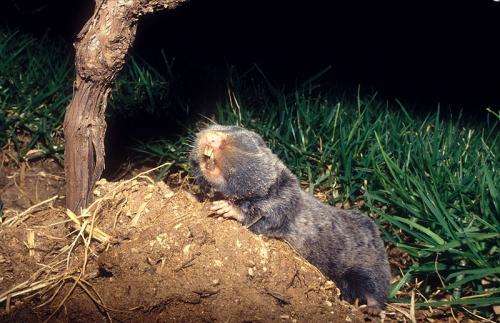January 30, 2013 report
Researchers claim to have found possible example of sympatric speciation

(Phys.org)—A research team working in Israel has found what might possibly be an example of evolutionary divergence in action – and it's not due to a natural barrier. In their paper published in the Proceedings of the National Academy of Sciences, the researchers describe how blind mole rats living nearly side-by-side in the Upper Galilee Mountains, have been found to possess a difference in their mitochondrial DNA, of up to 40 percent.
Evolutionary science suggests that new species develop when a natural barrier arises between groups of the same species – water levels rising, for example, causing islands to develop and subsequent divergence of the animal populations. This is known as allopatric speciation. But there's another way for a new species to develop, some scientists claim, and it has nothing to do with a natural barrier. They suggest that some species diverge even when there is no natural barrier between them. This is known as sympatric speciation, and the researchers in Israel believe they have found an example of it.
One part of the Upper Galilee Mountains has a very unique structure – igneous basalt rock has been pushed, via natural forces, up against chalk bedrock. The result is a very clear geographical dividing line with different kinds of plants growing in different soil types on either side of the line where the two meet. The researchers have found two groups of blind mole rats – one group lives on and above the basalt, while the other the chalk, that don't appear to comingle. Despite being the same species, the two groups appear to have stopped mating with one another at some point in the past, leading to differences in their DNA. And this, the team suggests, might be an example of the birth of a new species.
There are some obvious holes in the theory, of course. The team isn't able to prove that the moles weren't separated physically somehow in the past, nor can they say for sure that over time, the moles on either side of the line will eventually be unable to mate and reproduce with each other – a necessity for describing them as being of two different species. Still, the research has sparked renewed interest in the idea of sympatric speciation, and that will likely lead to more research being conducted in areas with similar geographic dividing lines.
More information: Possible incipient sympatric ecological speciation in blind mole rats (Spalax), PNAS, Published online before print January 28, 2013, doi: 10.1073/pnas.1222588110
Abstract
Sympatric speciation has been controversial since it was first proposed as a mode of speciation. Subterranean blind mole rats (Spalacidae) are considered to speciate allopatrically or peripatrically. Here, we report a possible incipient sympatric adaptive ecological speciation in Spalax galili (2n = 52). The study microsite (0.04 km2) is sharply subdivided geologically, edaphically, and ecologically into abutting barrier-free ecologies divergent in rock, soil, and vegetation types. The Pleistocene Alma basalt abuts the Cretaceous Senonian Kerem Ben Zimra chalk. Only 28% of 112 plant species were shared between the soils. We examined mitochondrial DNA in the control region and ATP6 in 28 mole rats from basalt and in 14 from chalk habitats. We also sequenced the complete mtDNA (16,423 bp) of four animals, two from each soil type. Remarkably, the frequency of all major haplotype clusters (HC) was highly soil-biased. HCI and HCII are chalk biased. HC-III was abundant in basalt (36%) but absent in chalk; HC-IV was prevalent in basalt (46.5%) but was low (20%) in chalk. Up to 40% of the mtDNA diversity was edaphically dependent, suggesting constrained gene flow. We identified a homologous recombinant mtDNA in the basalt/chalk studied area. Phenotypically significant divergences differentiate the two populations, inhabiting different soils, in adaptive oxygen consumption and in the amount of outside-nest activity. This identification of a possible incipient sympatric adaptive ecological speciation caused by natural selection indirectly refutes the allopatric alternative. Sympatric ecological speciation may be more prevalent in nature because of abundant and sharply abutting divergent ecologies.
Journal information: Proceedings of the National Academy of Sciences
© 2013 Phys.org










.jpg)







